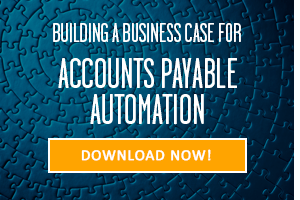Accounts payable (AP) and finance teams are acutely aware of the benefits of that AP automation has to offer. However, before an automated AP project can hit the ground running, there is one critical hurdle that must be cleared: getting buy-in from upper management and other key stakeholders.
Having worked with over 5,000 AP departments, capturing and processing millions of vendor invoices each month, the Esker team has gained valuable insights into what’s required for a successful digital transformation of AP. Over the past 30+ years, we have seen many well-intentioned AP automation projects stall or fail to start due the lack of a sound business case with clear and definable outcomes. Over the next few weeks, we will share some of those lessons learned in our series “Building the Business Case for Digital Transformation of AP”. These steps will include reusable tools, benchmarking data, and content that will help you build your own customized and compelling case for an AP digital transformation project.
Step 1: Defining Objectives & Assessing Current AP Process & Costs
Today’s fast-paced and ever-evolving business landscape demands that senior leadership focus on streamlining business functions as much as possible. This places greater emphasis on things like cash forecasting and spend analytics, lean growth management, integrating merger and acquisitions, and regulatory compliance.
It is, therefore, the responsibility of AP and finance managers to demonstrate how AP automation will not only modernize the AP department but also translate into quantifiable benefits for the entire organization. By building a strategic business case for AP automation reinforced with Key Performance Indicators (KPIs), AP and finance leaders will substantially increase their probability of convincing management that:
- The benefits of AP automation are too encompassing to take a back seat to other projects
- Their IT department will not be burdened with new infrastructure requirements or development projects
- Any new solution will not require transformative changes on the part your AP staff or suppliers
- Automated AP invoicing is not only a cost-savings initiative, but a potential revenue generator (more on this in Step 2) that increases productivity for all key stakeholders
It can be difficult to stick to a strategy if you fail to first identify what the project plans to accomplish. This can include defining what aspects of AP you wish to automate and what type of solution you want to pursue. For example, do you plan to automate all components of the AP process, or would a phased approach be better suited for your organization? We have seen many of our customers’ leverage this approach as it can provide value relatively quickly and serve as the foundation for the next phase, including funding and end-user support. For example, many AP teams will start out by digitizing paper based or non-EDI based invoices since the benefits of automating those manual processes is clear.
Common Considerations For AP Automation:
- Front-end data capture: OCR vs. AI-driven machine learning
- “Straight-through” processing
- 3-way matching
- Handling exceptions
- Supplier self-service portal
- Mobile capabilities
- Real-time visibility of accrued expenses
- Integration points
- Approval workflows
- Dashboards and reporting; including spend analytics
- Archiving of tax, audit and other key business data
Keep an eye out for Part 2 of this series, where we’ll cover how to identify your Key Performance Indicators, calculate ROI and align with organizational vision/strategy. In the meantime, check out this eBook to further expand on the ideas covered in this post.


